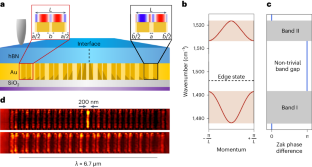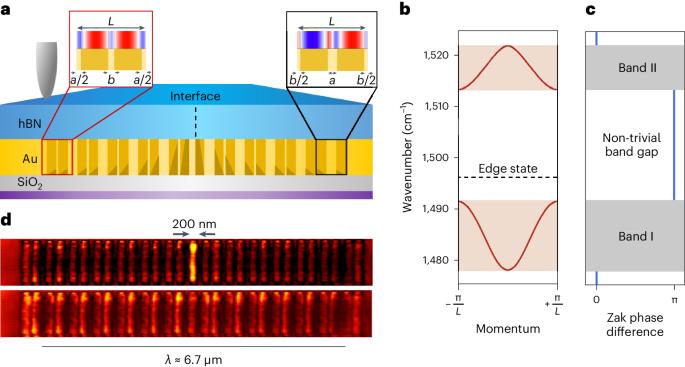双曲介质中的深亚波长拓扑边缘态。
IF 38.1
1区 材料科学
Q1 MATERIALS SCIENCE, MULTIDISCIPLINARY
引用次数: 0
摘要
拓扑光子学为控制光的传播提供了机会,这种方法不受制造失调和缺陷的影响。然而,实验演示仍然停留在真空波长的数量级上。理论上的建议表明,拓扑边缘态可以稳健地传播,同时具有深亚波长约束,打破了衍射极限。在这里,我们通过在范德华异质结构中对双曲声子极化子进行周期性调制,展示了这些深亚波长拓扑边缘态的实验证明,该异质结构由图案化金薄膜上的同位素纯六方氮化硼薄片组成。拓扑边缘态被限制在 0.021 µm3 的亚衍射体积内,比用于探测该系统的自由空间激发波长体积小四个数量级,同时共振品质因数保持在 100 以上。这一发现可以直接扩展到其他范德华材料并与之杂交,从而拓宽工作频率范围,简化各种极性材料的集成,并与电子和激子系统兼容。本文章由计算机程序翻译,如有差异,请以英文原文为准。


Deep subwavelength topological edge state in a hyperbolic medium
Topological photonics offers the opportunity to control light propagation in a way that is robust from fabrication disorders and imperfections. However, experimental demonstrations have remained on the order of the vacuum wavelength. Theoretical proposals have shown topological edge states that can propagate robustly while embracing deep subwavelength confinement that defies diffraction limits. Here we show the experimental proof of these deep subwavelength topological edge states by implementing periodic modulation of hyperbolic phonon polaritons within a van der Waals heterostructure composed of isotopically pure hexagonal boron nitride flakes on patterned gold films. The topological edge state is confined in a subdiffraction volume of 0.021 µm3, which is four orders of magnitude smaller than the free-space excitation wavelength volume used to probe the system, while maintaining the resonance quality factor above 100. This finding can be directly extended to and hybridized with other van der Waals materials to broadened operational frequency ranges, streamline integration of diverse polaritonic materials, and compatibility with electronic and excitonic systems. A photonic topological edge state, achieved by employing hexagonal boron nitride and patterned gold films, confines light four orders of magnitude below the diffraction limit while preserving a high quality factor.
求助全文
通过发布文献求助,成功后即可免费获取论文全文。
去求助
来源期刊

Nature nanotechnology
工程技术-材料科学:综合
CiteScore
59.70
自引率
0.80%
发文量
196
审稿时长
4-8 weeks
期刊介绍:
Nature Nanotechnology is a prestigious journal that publishes high-quality papers in various areas of nanoscience and nanotechnology. The journal focuses on the design, characterization, and production of structures, devices, and systems that manipulate and control materials at atomic, molecular, and macromolecular scales. It encompasses both bottom-up and top-down approaches, as well as their combinations.
Furthermore, Nature Nanotechnology fosters the exchange of ideas among researchers from diverse disciplines such as chemistry, physics, material science, biomedical research, engineering, and more. It promotes collaboration at the forefront of this multidisciplinary field. The journal covers a wide range of topics, from fundamental research in physics, chemistry, and biology, including computational work and simulations, to the development of innovative devices and technologies for various industrial sectors such as information technology, medicine, manufacturing, high-performance materials, energy, and environmental technologies. It includes coverage of organic, inorganic, and hybrid materials.
 求助内容:
求助内容: 应助结果提醒方式:
应助结果提醒方式:


